The Economics and Statistics Division maintains archives of previous publications for accountability purposes, but makes no updates to keep these documents current with the latest data revisions from Statistics Canada. As a result, information in older documents may not be accurate. Please exercise caution when referring to older documents. For the latest information and historical data, please contact the individual listed to the right.
<--- Return to Archive
For additional information relating to this article, please contact:
August 25, 2021BUSINESS COUNTS IN NOVA SCOTIA, JUNE 2021 Statistics Canada noted that business counts as of June 2021 may not yet fully reflect impacts of the pandemic. Resumption or permanent closure of businesses may not yet be fully processed and confirmed.
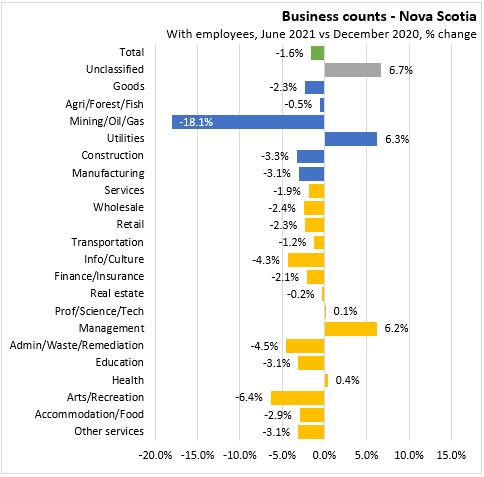
The number of business locations in Nova Scotia with employees declined 1.6% between Dec-2020 and Jun-2021. The number of goods producing locations decreased 2.3%, and total services sector locations decreased 1.9%.
For goods producing locations in Nova Scotia with employees, the largest declines were registered in mining/oil/gas, followed by construction and manufacturing. Utilities registered the only increase in goods producing locations.
For services producing locations in Nova Scotia with employees, all industries except professional, scientific and technical services, management of companies and enterprises and health care and social assistance registered declines in the number of locations. The largest declines, in percentage terms, were registered in arts, entertainment and recreation, administrative, waste management and remediation, and informational and cultural industries.
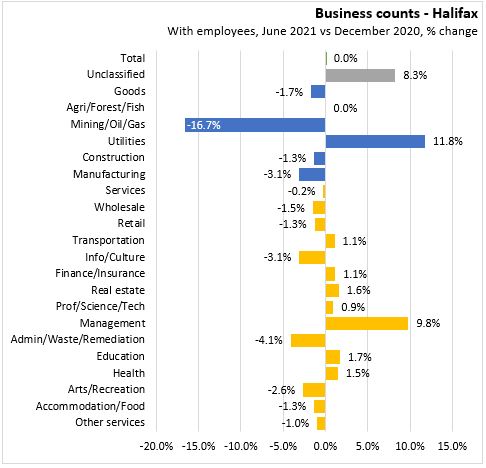
The number of business locations in Halifax was virtually unchanged from the previous period. Overall goods producing businesses declined by 1.7% while service producing businesses declined by 0.2%.
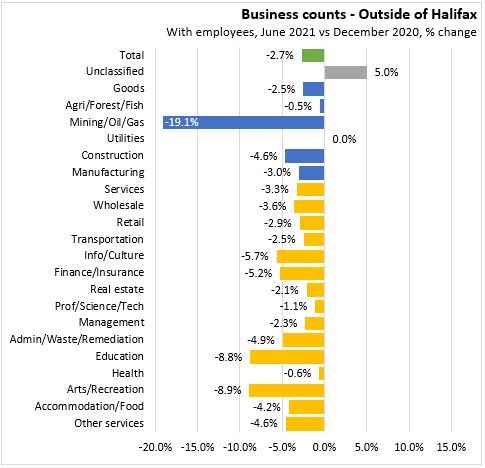
Outside of Halifax, the number of business locations declined by 2.7% with all industries except utilities reporting a decline in the number of business locations. Unclassified business locations increased by 5.0% compared to December 2020.
Provincially by Sector
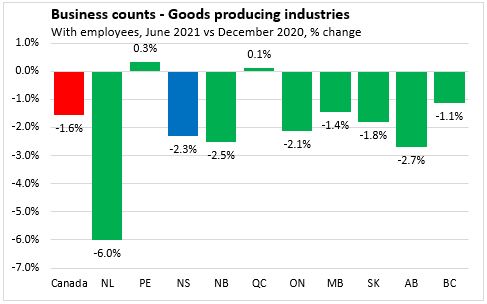
Nationally, goods sector locations with employees declined 1.6% from Dec-2020 to Jun-2021. In percentage terms, the largest decline was reported for Newfoundland and Labrador (-6.0%), followed by Alberta (-2.7%) and New Brunswick (-2.5%). Prince Edward Island (+0.3%) and Quebec (+0.1%) reported the only increases among provinces.

From Dec-2020 to Jun-2021, the number of services sector locations with employees declined 1.3% across Canada. All provinces registered declines, with Newfoundland and Labrador (-2.7%) and Prince Edward Island (-2.6%) reporting the largest declines in percentage terms.

Nationally, total business counts for locations with employees declined 0.8% from Dec-2020 to Jun-2021. All provinces except Quebec (+0.1%) reported declines, with the largest decline in percentage terms reported for Newfoundland and Labrador (-3.1%), followed by New Brunswick (-2.1%).
Census subdivisions
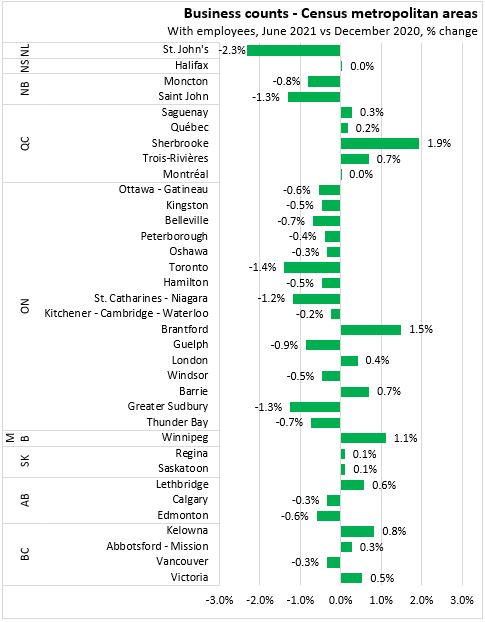
Among census metropolitan areas, Sherbrooke (+1.9%) and Brantford (+1.5%) reported the largest increases in business locations. The largest declines were reported for St. John’s (-2.3%) and Toronto (-1.4%) when comparing June 2021 to December 2020.
Key definitions for Statistics Canada's Business Register:
Statistical Enterprise
An enterprise is the legal operating entity at the top of the operating structure. There is only one enterprise per operating structure. It is associated with a complete set of financial statements.
Statistical Establishment
A statistical establishment is the production entity or the smallest grouping of production entities which:
- Produces a homogeneous set of goods or services;
- Does not cross provincial boundaries; and
- Provides data on the value of output together with the cost of principal intermediate inputs used along with the cost and quantity of labour resources used to produce the output.
- For example, a plant in the manufacturing industry which provides accounting information regarding the value of shipments (sales), direct costs and labour costs is considered a single establishment. However, two stores in the retail industry may be considered one establishment if the accounting information, described in item (c) above, is not available separately, but is combined at a higher level.
Statistical Location
The location is an operating entity, specifically a production entity which:
- Conducts economic activity at or from a single physical location or group of locations;
- Resides within the smallest standardized geographical area;
- Is able to provide employment data at a minimum.
- Multiple locations can be found under a single enterprise.
Sources:
Canadian Business Counts, with employees, June 2021
Canadian Business Counts, with employees, December 2020
<--- Return to Archive